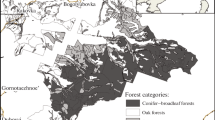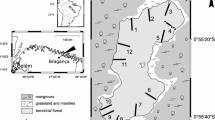Abstract
Phytosociological records were made in 80 stands lying in 50 small woodland islands in the Wierzbanówka valley. The types of communities were distinguished on the basis of numerical classification of records. These were mainly fragments of theTilio-Carpinetum association. For all the stands and for two groups of stands connected with various soils and localized mainly in the eastern or western part of the valley the statistical relationships between ten independent variables were examined (area of record, area of woodland island, its shape, distance to the nearest large woodland, mean distance to the three nearest woodland islands and others) and 10 dependent variables (number of species of trees, shrubs, herbaceous plants, species characteristic of the classesQuerco-Fagetea, Vaccinio-Piceetea, Molinio-Arrhenatheretea, Rudero-Secalietea and others). It was found that the floristic composition of the communities investigated was connected primarily with the isolation of the woodland islands. With increasing isolation the total number of species decreased, as did the number of herbaceous plants and that of herbaceous plants of the classesQuerco-Fagetea andVaccinio-Piceetea, while the number of species of the classesMolinio-Arrhenatheretea andRudero-Secalietea increased. Conditions of the habitat such as the inclination of slopes, shading, and soil fertility were less important.
Similar content being viewed by others
Literature Cited
Drużkowski M., Wójcik A.. etZuchiewicz W. (1984): Dolina Wierzbanówki: 2. Budowa geologiczna, rzeźba i współczesne procesy morfogenetyczne. (The Wierzbanówka Valley: 2. Geological structure, relief and present-day morphogenetic processes.).—Zesz. Nauk. UJ, Prace bot., Kraków, 12: 27–41.
Dzwonko Z. (1986): Klasyfikacja numeryczna zbiorowsk leśnych polskich Karpat. (Numerical classification of the Polish Carpathian forest communities.)—Fragm. Flor. Geobot., Kraków, 30: 93–167.
Feath S. H.. etKane T. C. (1978): Urban biogeography. City parks as islands forDiptera andColeoptera.—Oecologia, Berlin, 32: 127–133.
Hoehne L. M. (1981): The groundlayer vegetation of forest islands in an urban-suburban matrix.—In: Forest Island Dynamics in Man-Dominated Landscapes (Ed. byR. L. Burgess andD. M. Sharpe).—New York, p. 41–54.
Langer M.: Dolina Wierzbanówki: 16. Typy gleb i mapa ich rozmieszczenia. (The Wierzbanówka Valley: 16. Soil types and the map of their distribution.)—Zesz. Nauk. UJ, Prace bot., Kraków, 16, (in press).
Levenson J. B. (1981): Woodlots as biogeographic islands in Southeastern Wisconsin. In: Forest Island Dynamics in Man-Dominated Landscapes (Ed. byR. L. Burgess andD. M. Sharpe).—New York, p. 13–39.
Medwecka-Kornaś A. etDubiel E. (msc.): Mapa zbiorowisk roślinnych doliny Wierzbanówki (1: 5 000). Instytut Botaniki UJ, Kraków.
Medwecka-Kornaś A., Towpasz K. etGawroński S.: Dolina Wierzbanówki: 17. Zespoły leśne i mapa naturalnej roślinności potencjalnej. (The Wierzbanówka Valley: 17. Forest associations and the map of potential natural vegetation.)—Zesz. Nauk. UJ, Prace bot., Kraków, 16, in press.
Peterken G. F.. etGame M. (1984): Historical factors affecting the number and distribution of vascular plant species in the woodlands of Central Lincolnshire.—J. Ecol., London, 72: 155–182.
Scanlan M. J. (1981): Biogeography of forest plants in the prairie-forest ecotone in western Minnesota. In: Forest Island Dynamics in Man-Dominated Landscapes (Ed. byR. L. Burgess andD. M. Sharpe).—New York, p. 97–124.
Sneath P. H. A.. etSokal R. R. (1973): Numerical taxonomy. The principles and practice of numerical classification.—Freeman a. Comp., San Francisco, pp. 573.
Weaver M.. etKellman M. (1981): The effects of forest fragmentation on woodlot tree biotas in Southern Ontario.—J. Biogeogr. 8: 199–210.
Zarzycki K. (1984): Ekologiczne liczby wskaźnikowe roślin naczyniowych Polski. (Indicator values of vascular plants in Poland.)—PAN—Instytut Botaniki, Kraków, pp. 45.
Author information
Authors and Affiliations
Rights and permissions
About this article
Cite this article
Dzwonko, Z., Loster, S. The number and distribution of vascular plant species in island forest communities in the northern part of the West Carpathian foothills. Folia geobot. phytotax. 23, 1–16 (1988). https://doi.org/10.1007/BF02853292
Received:
Issue Date:
DOI: https://doi.org/10.1007/BF02853292




